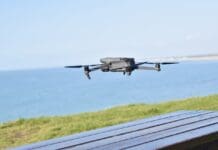This post is also available in:
 עברית (Hebrew)
עברית (Hebrew)
A new development in the aerial technology industry is trying to create a drone that will be released from a high-altitude balloon carrying a payload to evaluate how the equipment could help the FAA detect and track commercial spacecraft re-entering the National Air Space (NAS) as it descends from space. The drone simulates the return of a spacecraft through controlled airspace.
A test was conducted by Near Space Corporation (NSC) at the first FAA (UAS) test site for UAS high-altitude Certificate of Authorization (COA). With that flight, NSC became the first commercial suborbital space company to conduct a flight test under the agency’s UAS rules.
Tim Lachenmeier, Near Space CEO said: “It took a long time, and a lot of dedicated support from the FAA to get this accomplished.”
NASA’s Flight Opportunities program, according to its site, under the agency’s Space Technology Mission Directorate, funded the balloon flight of the FAA surveillance technology system. The program uses commercial suborbital vehicles and stratospheric balloons to test flight technologies, which raises the technology readiness level of the payloads.
The stratospheric balloon system reached 70,000 feet altitude before it released the NSC’s High Altitude Shuttle System (HASS) drone to simulate a winged spacecraft’s entry into FAA Class A controlled airspace. The descent back to the launch site lasted slightly over 30 minutes and was followed by the FAA using the new surveillance technology.
The agency tracked the HASS drone from its Seattle Air Traffic Control Center and was observed by agency personnel at the FAA’s Office of Commercial Space Transportation in its Washington DC offices.
The flight provided a real-world simulation of a spacecraft re-entry to help evaluate the applicability of FAA’s Next Generation air traffic control technologies. Due to current FAA UAS regulations, a special new high-altitude COA was required.
The agency issued the COA in August 2016 along with an agreement that specified the special Air Traffic Control provisions for high-altitude flight operations within the Tillamook (Oregon) UAS Test Range.
The purpose of a COA is to specifically help prescribe flight rules for UAS operations in the NAS for the purpose of research, development, test and evaluation. Results of the flight test are still being analyzed but planning for a second flight is underway.
























